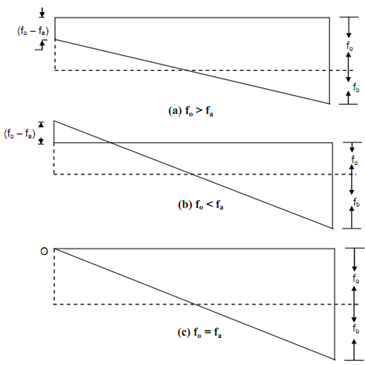Load Acting Eccentric to One Axis:
The bending couple P × e will cause longitudinal tensile & compressive stresses. The fibre stress because of bending f0, at any distance 'y' through the neutral axis is given by,
fb = ( M/ I xx) × y = (P × e × y )/ I xx (tensile or compressive) ------ (1)
Therefore, the total stress at any section is given by following
f = f0 ± f = (P/A) ± ((P × e × y )/ I xx) --------- (2)
f = (P/A) ± (M/ Z xx) [where P × e = M and I xx /y = Z xx (the section modulus)].
The extreme fibre stresses are given by following,
f max = f0 + f b = P /A + (M/ Z xx)
f min = f0 - f b = P /A - (M/ Z xx) ----------- (3)
If f0 is greater than fb, the stress during the section shall be of the similar sign. If though, f0 is less than fb, the stress shall change sign, being partly tensile & partly compressive across the section. Therefore, there might be three possible stress distributions as illustrated in Figures (a), (b) & (c). You might observe from Figure (c), that while
f0 = fb, fmax = 2f0 and fmin = 0.

Figure